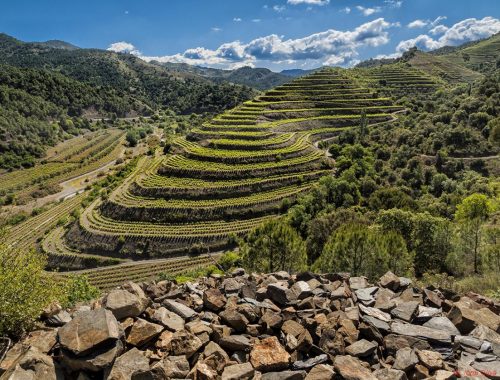22 Mar El Priorat

Catalina la Influencer nos acompaña...
Al Priorat para intentar contextualizar sus vinos con todo lo que lo envuelve. Para ello vamos a ver la comarca (zona territorial) en sí, la orografía y las variedades de uvas. Es difícil entender el Priorat sin su viticultura. Una larga historia nos ayuda a entenderla como proceso respetuoso y cómplice con el medio natural. El trato que desde siempre se ha otorgado en esta tierra al ámbito agrícola, se ha mantenido casi intacto hasta tiempos recientes. ¡Pero veamos estas particularidades!
Primera rareza, nos encontramos con un clima continental, un caso extraño estando a 70 kilómetros del mar Mediterráneo. En verano es seco y muy caluroso, mientras que en invierno muy frío con bastantes nevadas.
Segunda, el suelo principalmente es de pizarra. Un paisaje compacto, bien definido, constituido por el gran anfiteatro montañoso que se abre a los pies de la sierra del Montsant y con la sierra de Llaberia. Estamos hablando de roca de hace 400 millones de años.
Tercera, es el territorio de la “Llicorella”: desde unos montes con suaves líneas de crestas a unas vertientes con pendientes impracticables. Con esta situación la única forma de conrear la vid es mediante “costers” (cuestas) con pendientes tan pronunciadas que en algunos casos hay que construir las “terrazas”. ¡Que osados lo primeros viticultores que se embarcaron en esta titánica tarea! No en valde se utiliza el mote “agricultura heroica”. La configuración del cultivo se caracteriza por pendientes que superan el 15% de desnivel en la mayor parte de casos, y algunas fincas llegan al 60%. Debida a la tortuosa geografía de la zona, la maquinaria no llega a los “costers” y obliga a nuestros viticultores a trabajar de la forma más tradicional.
Cuarta rareza: a causa del tipo de terruño y del clima tan peculiares, la cepa sufre de manera importante y, como consecuencia, se obtienen unas vendimias más bien escasas, con unos rendimientos de uva bastante bajos (no superan la cantidad de 1 kg. por planta como media), pero que otorgan a los vinos su identidad tan singular. Estos viñedos normalmente tienen cepas muy viejas, de variedades autóctonas y de ellas se elaboran vinos de gran calidad. La Garnacha y la Cariñena son las variedades estrellas de estos paisajes.
Y ya hablando de la vid, el cultivo de la viña se distribuye en altitudes que van desde los 100 metros sobre el nivel del mar en las partes más bajas de los términos de Bellmunt del Priorat y el Molar (donde está el Celler Grifoll Declara), hasta los 750 metros en las partes elevadas de los términos de la Morera de Montsant y Porrera (con la bodega Giol Porrera). A orillas del río Siurana, donde se instala el Celler Escoda Palleja, en Torroja o Clos Pachem que está en Gratallops, sede de la cooperativa agrícola y del Consell Regulador de la Denominación de Origen Cualificada (DOQ) Priorat.
El paisaje que generan estos viñedos es una de las características del Priorat, que le aportan esta personalidad e identidad tan propias, y este paisaje y estas características son la personalidad e identidad de los vinos DOQ Priorat.





